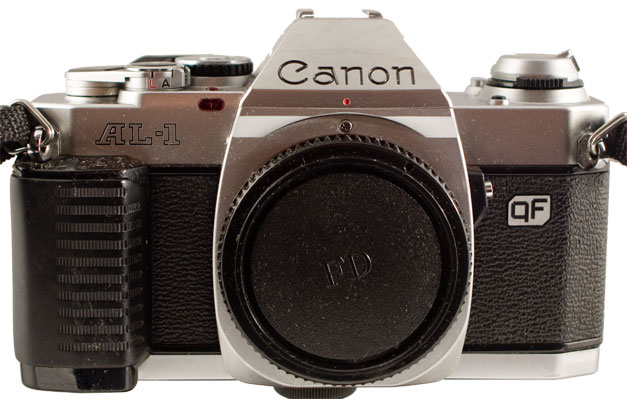
Lens Mount: FD bayonet/breech
Format: 35mm film
Battery: two 1.5v AA
Approx. dates of manufacture: 1983 - 1985
Approx. original price: $129
Approx. street value: Low-Moderate
The big R&D push in the 70s and 80s was auto-focus. Simple cameras had fixed-focus lenses, but that just meant the lenses couldn't be adjusted at all; so you got decent focus at average distances and poorer focus everywhere else. The problem was how to adjust the lens so it could bring an image into sharp focus automatically.
It would take a while (and some stumbles) before Canon released its autofocus EOS line of cameras, but in 1983 they decided to sell one of the evolutionary steps. The AL-1 did not have autofocus, it had focus confirmation. Inside the viewfinder there were two LED arrows and a dot. The arrows said that the image was out of focus in one direction or another; when the dot lit up, the image was in-focus. Canon called this feature QF for "quick focus."
It didn't go over well. It was okay if you had terrible eyesight, but the times when QF would really be of value—when the viewfinder is dim and the image is hard to focus by eye, then the QF feature would have been a great help. Unfortunately that the QF struggled in exactly the same places the human eye struggled: low light. Other than the QF feature, there was no compelling reason to buy the AL-1 instead of the more fully-featured AE-1 or AE-1 Program. It was no surprise that QF was not incorporated into Canon's newer T series cameras.
.jpg) The one nice thing about the AL-1, which would carry over to some newer cameras, was its use of two standard
AAA size batteries. On the surface it seems a step backward; camera batteries get heavier and bulkier as cameras come to depend more on them. So battery size and weight goes up, but at least you can buy AAAs at any supermarket, liquor store or gas station on the road.
And it's a good bet that AAAs will be manufactured for decades to come—long after more exotic camera batteries are gone.
The one nice thing about the AL-1, which would carry over to some newer cameras, was its use of two standard
AAA size batteries. On the surface it seems a step backward; camera batteries get heavier and bulkier as cameras come to depend more on them. So battery size and weight goes up, but at least you can buy AAAs at any supermarket, liquor store or gas station on the road.
And it's a good bet that AAAs will be manufactured for decades to come—long after more exotic camera batteries are gone.
I got my camera from an auction because the battery door was broken, so the batteries wouldn't stay in and you'd have to hold it closed (with considerable effort) to get the camera to run. I bought a new battery door from Huron Camera, which was pricey but they're one of the places who sell these things directly to amateur repair people like me. Took a little work to get the door installed but I didn't break anything (came close, though). I can see why the doors on these break: you have two spring-loaded batteries pressing on a very small little plastic tab; plus the door closes hard anyway—you really have to go easy on opening and closing the door. Good idea but poorly engineered. The Canon T70 had a similar battery compartment but the loading door is much beefier.
For more information: Canon Camera Museum
Modern Photography magazine camera test: August 1982
One of Modern Photography magazine's Top Cameras
Camera manual: Orphan Cameras.com



